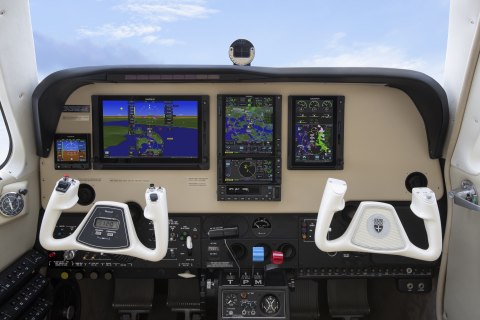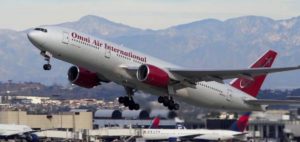- GTN 650Xi & GTN 750Xi modernize cockpit navigation and are available immediately
OLATHE, Kan.–(BUSINESS WIRE)– Garmin International, Inc., a unit of Garmin Ltd. (NASDAQ: GRMN), today announced the GTN™ 650Xi and GTN 750Xi, the next generation of in-flight navigation technology. Designed as a direct slide-in upgrade to the previous generation GTN 650/750, pilots can preserve their panel and modernize the cockpit with the new GTN 650Xi and GTN 750Xi. The all-in-one GPS/NAV/COMM boasts a feature-rich multifunction display and can integrate with new or existing remote-mount equipment such as a transponder or audio panel. Dual-core processors and modern hardware also prepare the GTN Xi series for advanced capabilities in the future. The GTN 650Xi and GTN 750Xi have received Federal Aviation Administration (FAA) approval and are available immediately for fixed-wing single-engine and multi-engine piston, turbine and experimental aircraft, with helicopter and business aircraft approvals soon to follow.
This press release features multimedia. View the full release here: https://www.businesswire.com/news/home/20200108005138/en/

GTN 750Xi and GTN 650Xi in the panel of a Bonanza (Photo: Business Wire)
“After decades of innovation and pioneering the GPS/NAV/COMM, we’re excited to bring the fourth generation GTN 650Xi and GTN 750Xi to the market,” said Carl Wolf, vice president of aviation sales and marketing. “Garmin was the first to introduce the all-in-one navigator with the iconic GNS 430/530. Over time the GNS WAAS and the industry-first GTN 650/750 touchscreen navigators were added to the line-up along with state-of-the-art features such as voice control, wireless connectivity and more. As the leader in GPS cockpit navigation, we have brought the most widely adopted navigators to the industry and with the GTN 650Xi and GTN 750Xi, we’re excited to add one more to the family.”
Modern processing power and state-of-the-art hardware within the GTN 650Xi/750Xi supports faster map rendering and smoother panning throughout the touchscreen navigator. It boasts a large, ultra-high-resolution display and wide viewing angle that offers superior readability in the cockpit. The displays initialize within seconds of start-up, providing immediate access to frequencies and flight plan information, saving valuable time in the aircraft. Preserving the same form factor as the previous generation GTN 650/750, the 6-inch-tall GTN 750Xi and the 2.65-inch-tall GTN 650Xi offer an intuitive touchscreen design with a dedicated direct-to button and dual concentric knob that provide added convenience when interfacing with the display.
Retaining all the features of the GTN 650/750, the GTN Xi series adds a vibrant display and vivid colors that enhance the contemporary look of the new navigators. When installed alongside a G500 TXi or G600 TXi flight display, the GTN Xi series brings a new level of modernization to the cockpit. Highly complementary, the GTN Xi and the TXi flight displays share similarities in display, appearance and hardware qualities. For example, both products feature an angular bezel so the pilot has a near-seamless experience when transitioning between the touchscreen flight display and the navigator.
The GTN 650Xi/750Xi offer advanced navigation functions, including ILS and LPV instrument approach procedures, as well as visual approach guidance. Based on a published glide path angle or a three-degree glideslope from the threshold of the runway, visual approaches also take into account terrain and obstacle clearance to assist pilots in flying a stabilized approach to the runway in visual flight conditions. Approach types that incorporate radius-to-fix (RF) leg types are also supported by the GTN Xi series. Additional capabilities include the option to add a published or custom holding procedure, vertical navigation (VNAV), graphical flight plan editing on the moving map and more.
The colorful, multifunction display-like map allows pilots to better visualize their dynamic position relative to potential hazards, such as terrain, weather and traffic. Geo-referenced instrument approach procedures can be overlaid on the map page, offering superior situational awareness when transitioning from the enroute to approach phase of flight. Terrain alerting is included within the GTN Xi series and further enhances situational awareness by using its internal terrain and obstacle database to provide audible and visual terrain proximity alerts, including, “terrain ahead, pull up” and “obstacle ahead, pull up.” Helicopter Terrain Awareness and Warning System (HTAWS), TAWS-A and TAWS-B are available as options.
Superior integration with an array of avionics on the market make the GTN 650Xi/750Xi a simple and straightforward solution to incorporate into any cockpit. Options for remote audio panel or transponder display and control allow aircraft owners to simplify their panel. When paired with a Garmin autopilot, such as the GFC™ 500 or GFC 600, pilots can fly fully coupled VNAV profiles and instrument approach procedures. Pilot workload-reducing features such as Telligence™ voice control are also available within the GTN Xi when paired with the optional GMA™ 35c. When paired with a GSR 56 Iridium datalink, global text and voice calling can be completed through the touchscreen display on the navigator.
Wireless connectivity is available with the optional Flight Stream 510, allowing pilots to connect their mobile devices running the Garmin Pilot™ and FltPlan Go applications to the GTN 650Xi/750Xi. When connected to the navigator, pilots can save time in the cockpit by wirelessly transferring aviation databases and flight plans from their mobile device to the navigator. Flight Stream 510 also supports the sharing of traffic, weather, GPS position information and more. The GTN Xi series is also compatible with the cost-effective Garmin navigation database.
The GTN 650Xi and GTN 750Xi have received FAA Supplemental Type Certification (STC) and are available immediately through Garmin Authorized Dealers for a suggested retail price of $12,495 and $17,995 respectively. A free GTN Xi trainer app is also available for download on Apple mobile devices, which allows customers to experience the feature set of these navigators. A new GTN Essentials 2.0 eLearning Course provides instruction on best practices for operational use of the new GTN Xi series and can be accessed via this website: https://buy.garmin.com/en-US/US/p/712644. The GTN Xi series come with a two-year warranty and are supported by Garmin’s award-winning aviation support team, which provides 24/7 worldwide technical and warranty support. Garmin was awarded top honors last year in avionics product support for the 16th straight year by Aviation International News,and earned the top spot in the annual avionics product support survey conducted by Professional Pilot magazinethis year, also for the 16th consecutive year.



